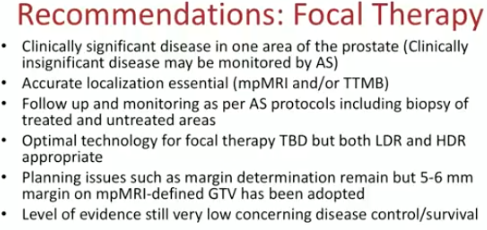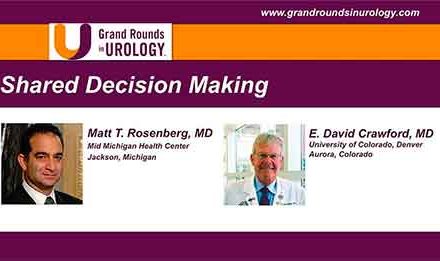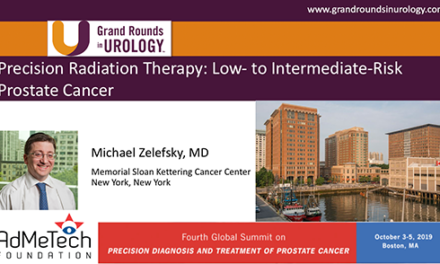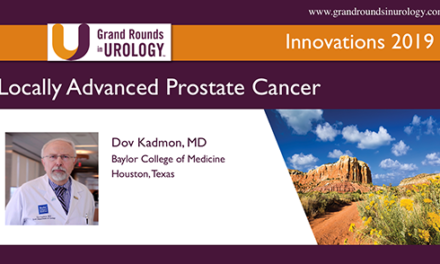Juanita M. Crook, MD, FRCPC, presented “Focal Brachytherapy” during the Southwest Prostate Cancer Symposium on April 15, 2018 in Scottsdale, Arizona.
How to cite: Crook, Juanita M. “Focal Brachytherapy” April 15, 2018. Accessed [date today]. https://grandroundsinurology.com/focal-brachytherapy-2/
Focal Brachytherapy – Summary
Juanita M. Crook, MD, FRCPC, argues that focal brachytherapy is one of the most effective and least invasive treatments for prostate cancer. She discusses patient selection for focal therapy, technical limitations, efficacy data, and best practices in post-focal-therapy monitoring.
Benefits of Focal Therapy
Dr. Crook explains the reasoning behind focal therapy, which originates from the problem that prostate cancer screening often diagnoses favorable risk disease with low disease burden. These conditions make active surveillance (AS) appropriate, but patients are often not comfortable with AS.
Patients sometimes prefer whole-gland definitive treatment over AS. However, whole-glad treatment may be excessive and associated with toxicity. Alternatively, focal therapy is more easily controlled and does not often result in toxicity.
As an illustration of these points, Dr. Crook reviews recent research and publications of focal therapy in this presentation.
Why Brachytherapy is an Optimal Focal Therapy Modality
When choosing a modality of focal therapy, one must consider three main requirements: the method’s proven efficacy in whole gland treatment, its capacity to monitor accuracy of treatment delivery, and a documented dose response relationship. This leaves the options for such therapy as low-dose rate (LDR) or high-dose rate (HDR) brachytherapy, cryotherapy, or high-intensity focused ultrasound (HIFU), as well as photodynamic therapy (PDT), electroporation, radiofrequency ablation (RFA), or laser treatment.
Dr. Crook believes brachytherapy is the best option because it meets her three main requirements. She then explains important considerations and outlines the proper steps clinicians should take when planning for focal therapy.
Importance of Accuracy in Brachytherapy: HDR Advantages Over LDR
Regarding the choice of LDR or HDR, Dr. Crook describes HDR’s clear advantages. LDR often results in seed loss and migration. Ultra-focal LDR plans are also very sensitive to seed displacement, which is less desirable for patient outcomes. Quality evaluation occurs after treatment, and seed correction is very difficult.
Conversely, HDR has precisely controlled and delivered doses with no seed loss, no organ motion, and no patient motion if there is US-based planning.
Why Focal Therapy?
The overall intent of focal therapy is to reduce acute morbidity. According to Dr. Crook, brachytherapy is more effective in this than other types of treatment. Data shows restricting high doses of treatment to a smaller volume of the prostate reduces morbidity in patients. While it may take slightly longer for a patient to recover, the focal brachytherapy treatment proves to be more effective than traditional techniques of treatment.
However, defining success of focal therapy is difficult. There is no validated PSA outcome, so active monitoring, similar to AS, is important when utilizing a focal therapy approach.
ABOUT THE AUTHOR
Juanita M. Crook, MD, FRCPC, completed her medical training at the University of Toronto and her residency in Radiation Oncology at Princess Margaret Hospital. She is currently a Professor of Radiation Oncology at the University of British Columbia in Kelowna. She is a radiation oncologist at the BC Cancer Agency Sindi Ahluwalia Hawkins Centre for the Southern Interior, also in Kelowna, where she has developed image-guided HDR gynecologic brachytherapy, US-planned HDR prostate brachytherapy, and permanent seed brachytherapy for breast cancer. Previously a Professor of Radiation Oncology at the University of Toronto/University Health Network and an Associate Professor at the University of Ottawa, she has a particular interest in intermittent androgen suppression, post-radiation prostate biopsies, and penile brachytherapy. She has written more than 20 book chapters and over 200 journal articles and is a frequent speaker at international meetings where she presents in English, French, and Spanish. She was Scientific Chair of the 2007 American Brachytherapy Society meeting and frequently teaches at the ABS Prostate Brachytherapy School. She is the former President of the Board of the American Brachytherapy Society and the recipient of the Thom Shanahan Distinguished Brachytherapy Educator Award.







